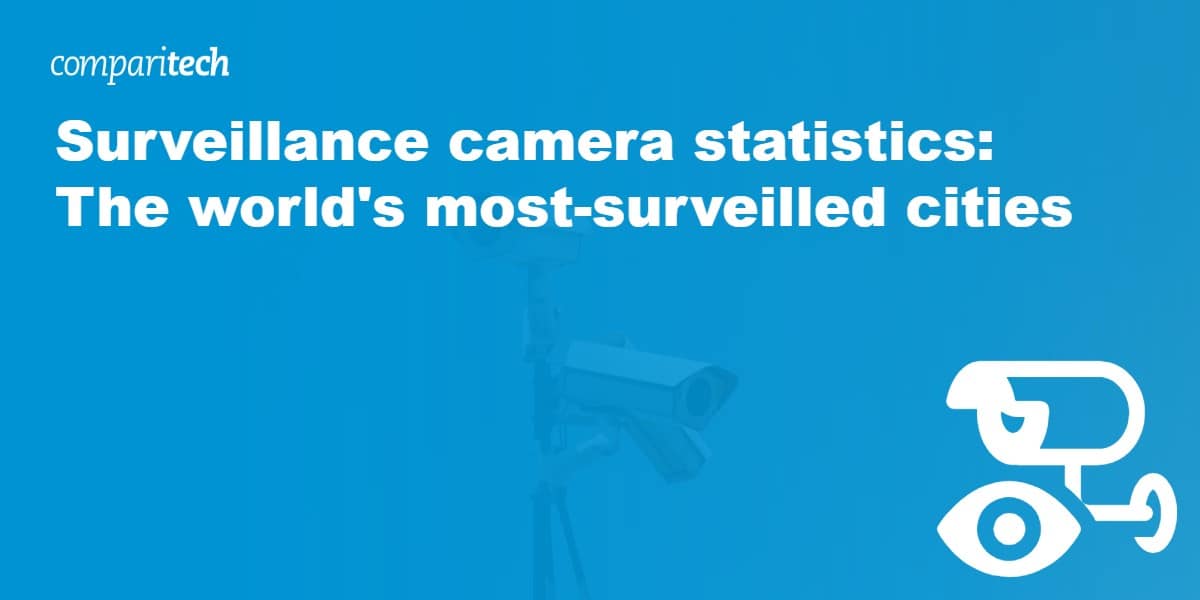
Cities in China are under the heaviest CCTV surveillance in the world, according to a new analysis by Comparitech. Globally, many more cities are under increasing amounts of surveillance.
It is incredibly difficult to put a figure on the total number of surveillance cameras in the world with estimates varying dramatically. However, IHS Markit suggested that there would be around 1 billion surveillance cameras worldwide from 2021 onward. 700 million of these are in China and form the SkyNet project, which is operated by the Chinese Communist Party.
Based on a population of 1.42 billion (using the most recent UN estimate), the current figure of 700 million cameras means there are 494.25 cameras per 1,000 people in China. That’s almost one camera for every two people.
We have used this ratio to create estimated CCTV camera figures per Chinese city. Due to wildly different estimates and old figures, this seemed the most accurate and fairest way to try and gauge the sheer volume of cameras in China.
While China yet again dominates this study for its vast surveillance tactics, there are other countries whose surveillance tactics are of growing concern, including several Indian, Russian, and South Korean cities, Lahore, Kabul, Singapore, London, Istanbul, New York, and Los Angeles.
In fact, the overall average number of cameras per 1,000 people across all cities has increased since our last update. Previously, we measured an average of 4.31 cameras per 1,000 people (123.74 per 1,000 people when including China), while today there are 5.82 cameras per 1,000 people (139.96 per 1,000 people when including China).
A number of cities have added (or are adding and/or are encouraging businesses/private residents to add) private surveillance cameras to police networks as part of crime-fighting initiatives. In some cases, these cameras are mapped so police can see where security cameras are and can request footage accordingly. In other cases, police are being given direct access to live feeds from these cameras. So, where cameras had previously been used for private security purposes only, thousands of these are now being accessed by police, which poses a significant risk to civilians’ privacy.
Comparitech researchers collated a number of data resources and reports, including government reports, police websites, and news articles, to get some idea of the number of CCTV cameras in use in 150 major cities across the globe. We focused primarily on public CCTV—cameras used by government entities such as law enforcement.
Please note: our previous study included the number of cameras per square mile of each city. However, in this update, this has been removed due to there being no central source for this data, which often creates wildly different estimates and doesn’t offer a fair comparison on a city-by-city basis.
Key findings:
- Hyderabad, Indore, Bangalore, Lahore, Seoul, Moscow, Kabul, Singapore, Saint Petersburg, and Baghdad are the top 10 most surveilled cities outside of China (based on the number of cameras per 1,000 people)
- A worrying number of cities are connecting private CCTV cameras to police networks, which is significantly increasing the number of “public” cameras across cities
- At the end of 2021, over one billion surveillance cameras were estimated to have been installed worldwide, according to IHS Markit’s latest report
- 700 million cameras form the SkyNet project in China
- We found little correlation between the number of public CCTV cameras and crime or safety
The 10 most surveilled cities in the world
Based on the number of cameras per 1,000 people, these cities are the top 10 most surveilled in the world:
- Cities of China* — 700m cameras to 1.42bn people = 494.25 cameras per 1,000 people
- Hyderabad, India — 900,000 cameras for 11,337,900 people = 79.38 cameras per 1,000 people
- Indore, India – 251,500 cameras per 3,482,830 people = 72.21 cameras per 1,000 people
- Bangalore, India – 585,284 cameras for 14,395,400 people = 40.66 cameras per 1,000 people
- Lahore, Pakistan – 410,297 cameras for 14,825,800 people = 27.67 cameras per 1,000 people
- Seoul, South Korea – 243,426 cameras for 10,025,800 people = 24.28 cameras per 1,000 people
- Moscow, Russia – 250,000 cameras for 12,737,400 people = 19.63 cameras per 1,000 people
- Kabul, Afghanistan – 90,000 cameras for 4,877,020 people = 18.45 cameras per 1,000 people
- Singapore, Singapore — 112,999 cameras for 6,157,270 people = 18.35 cameras per 1,000 people
- St. Petersburg, Russia — 102,000 cameras for 5,597,340 people = 18.22 cameras per 1,000 people
In this update, Bangalore replaces Delhi in India to take third place. This is due to a number of proposed cameras not being installed in Delhi, while police in Bangalore have recently geo-tagged over 535,000 public and private cameras to help act as the “eyes and ears of police” for crime detection.
Lahore, Pakistan, also enters the top 10 for similar reasons as Bangalore. Here, 400,000 private cameras have been mapped for “digital monitoring and crime control.” This is part of an initiative to map 2.5 million cameras across the whole of Punjab.
*As mentioned in the introduction, our estimates for Chinese cities this year are based on China as a whole.
Surveillance in London, UK
If we expand the number of cities with the most surveillance to the top 15, London enters the rankings in 12th position with 13.4 cameras per 1,000 people*. According to our findings, there are now over 130,000 public surveillance cameras in the United Kingdom’s capital city.
The borough with the highest density of cameras is the City of London (75.31 cameras per 1,000 people), followed by Hammersmith and Fulham (10.91), Islington (9.87), Hackney (9.11), and Westminster (8.09).
Often, a large number of these cameras are installed in the borough’s community housing estates, as we can see with the breakdown of figures provided by Islington (1,248), Hackney (1,980), and Westminster (1,400).
Please note: the population of each London borough is based on the 2021 census, whereas the overall population of London is based on 2025 estimates.
Surveillance in US cities
Los Angeles also enters the top 15, placed just behind London. It has 46,766 cameras, which equates to 12.4 cameras per 1,000 people. Recently, 115 AI cameras were installed to help locate wildfires, and the Los Angeles County Sheriff’s Office established a camera registry. So far, over 1,700 cameras have been registered (this allows police to see where a camera is installed) and a further 2,900 have been integrated (this gives police direct access to live camera feeds).
Note: some of these AI cameras and those accessed by the Sheriff’s Office may extend further than the city limits.
New York City places just outside the top 15 in 16th place with 80,303 cameras to a population of just over 7.9 million (10.12 cameras per 1,000 people).
The 10 most populated cities in the world (and their camera figures)
Most of the heaviest surveilled cities aren’t in the top 10 most populated cities. Let’s see how the world’s most populated cities compare when it comes to their camera figures per 1,000 people:
- Tokyo, Japan – 49,841 cameras for 37,036,200 people = 1.35 cameras per 1,000 people
- Delhi, India – 313,332 cameras for 34,665,600 people = 9.04 cameras per 1,000 people
- Shanghai, China – 15,065,778 cameras for 30,482,100 people = 494.25 cameras per 1,000 people
- Dhaka, Bangladesh – 3,512 cameras for 24,652,900 people = 0.14 cameras per 1,000 people
- Cairo, Egypt – 48,033 cameras for 23,074,200 people = 2.08 cameras per 1,000 people
- São Paulo, Brazil – 51,346 cameras for 22,990,000 people = 2.23 cameras per 1,000 people
- Mexico City, Mexico – 136,920 cameras for 22,752,400 people = 6.02 cameras per 1,000 people
- Beijing, China – 11,168,320 cameras for 22,596,500 people = 494.25 cameras per 1,000 people
- Mumbai, India – 82,390 cameras for 22,089,000 people = 3.73 cameras per 1,000 people
- Osaka, Japan – 21,703 cameras for 18,921,600 people = 1.15 cameras per 1,000 people
CCTV, crime, and safety
Closed-circuit television (CCTV) cameras serve many purposes, ranging from crime prevention to traffic monitoring to observing industrial operations in environments not suitable for humans. The digital age has boosted the prevalence of CCTV surveillance. Cameras are getting better and cheaper, while live video streams can be remotely accessed, stored on the internet, and passed around. The adoption of face recognition technology makes it possible for both public and private entities to instantly check the identity of anyone who passes by a CCTV camera.
Depending on whom you ask, the increased prevalence and capabilities of CCTV surveillance could make society safer and more efficient, could trample on our rights to privacy and freedom of movement, or both. No matter which side you argue, the fact is that live video surveillance is ramping up worldwide.
A primary argument in favor of CCTV surveillance is improved law enforcement and crime prevention. We compared the number of public CCTV cameras with the crime indices reported by Numbeo, which are based on surveys of that site’s visitors.

As you can see from the above chart, a higher number of cameras just barely correlates with a lower crime index.
Broadly speaking, more cameras don’t necessarily reduce crime rates.
China leads the world in CCTV surveillance
As previously mentioned, there are said to be 700 million cameras in China which form the SkyNet project. This equates to a total of 494.25 per 1,000 people.
While astronomical, we can see that other estimates place similar–if not higher–figures on these cities. For example, in Shenzhen, it was reported that there were 1.34m cameras in 2017 with 16.68m planned (our estimate suggests there are currently 6.7m).
Based on current projections of 494.25 cameras per 1,000 people, let’s look at the estimates for each Chinese city:
China is a fervent adopter of face recognition surveillance. It is often used to restrict individuals’ freedom of movement, such as restricting access to public transportation. Cameras equipped with face recognition technology are put in place at transportation hubs to enforce these rules.
Methodology
Comparitech researchers collated a number of resources to get an estimate of the number of public CCTV cameras in use. Delhi’s population is only for the metropolitan area, which our camera figures cover.
Where possible, we have only included public CCTV cameras, including cameras installed on public buildings, cameras used by law enforcement, cameras installed on public transport, and traffic cameras with surveillance capabilities (i.e. automatic number plate recognition). However, in some instances, it may not be clear what cameras are included, meaning some private camera figures may also be included in the totals. We believe this may be the case for Indore.
Due to a wide range of sources reporting estimates and a general lack of public information regarding CCTV cameras, actual figures may be higher or lower than what is indicated. To try and ensure our study is as fair and accurate as possible, we have opted for the lower figure where two different ones have been quoted.
Sometimes, camera figures decline due to projects previously quoted by governments not being carried out, or new updated sources providing more accurate estimates.
Most of the data sources used are from the last few years but, in some cases, only older data sources were found. The dates of the sources are listed in our sources sheet. Limitations are also noted in this sheet.
The cities omitted due to lack of data are: Lusaka, Yaounde, Kinshasa, Nagoya, Jeddah, Malappuram, Kumasi, and Kano.
Sources: For a full list of sources by country, please request access here.
Data researcher: Rebecca Moody
See also:

